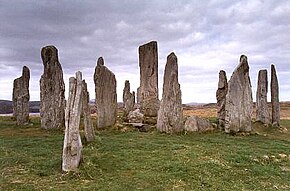Callanish Stones
| Clachan Chalanais | |

The stone circle at the centre of the Callanish Stones
|
|
| Alternate name | Callanish I |
|---|---|
| Location | Lewis |
| Coordinates | 58°11′52″N 6°44′39″W / 58.1979°N 6.7443°W |
| Type | Stone circle and rows |
| History | |
| Periods | Neolithic, Bronze Age |
The Callanish Stones (or "Callanish I", Clachan Chalanais or Tursachan Chalanais in Scottish Gaelic) are an arrangement of standing stones placed in a cruciform pattern with a central stone circle. They were erected in the late Neolithic era, and were a focus for ritual activity during the Bronze Age. They are near the village of Callanish (Gaelic: Calanais) on the west coast of Lewis in the Outer Hebrides, Scotland.
The Callanish Stones (grid reference NB213330) are situated on a low ridge above the waters of Loch Roag with the hills of Great Bernera as a backdrop.
Numerous other ritual sites lie within a few kilometres. These include at least three other circles, several arcs, alignments and single stones; many visible from the main site. The most impressive – Callanish II and Callanish III – lie just over a kilometre southeast of the main Callanish Stones, and originally consisted of circles of stones at least eight in number. The existence of other monuments in the area implies that Callanish was an active focus for prehistoric religious activity for at least 1500 years.
The Callanish Stones are managed by Historic Scotland. There is a visitor centre operated by Urras Nan Tursachan (The Standing Stones Trust).
The Callanish Stones consist of a stone circle of thirteen stones with a monolith near the middle. Five rows of standing stones connect to this circle. Two long rows of stones running almost parallel to each other from the stone circle to the north-northeast form a kind of avenue. In addition, there are shorter rows of stones to the west-southwest, south and east-northeast. The stones are all of the same rock type, namely the local Lewisian gneiss. Within the stone circle is a chambered tomb to the east of the central stone.
...
Wikipedia

